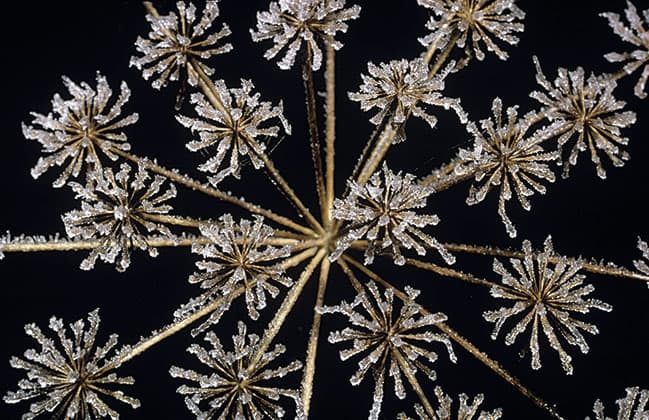Photo Insight with Heather Angel
Frosty plants can make beautiful photographic subjects. Heather Angel explains how she used ‘grazed flash’ to capture this magical image of frost on hogweed
 An internationally renowned photographer of the natural world and author of more than 50 books, Heather brings her expertise to AP.
An internationally renowned photographer of the natural world and author of more than 50 books, Heather brings her expertise to AP.
This image of frost on hogweed is one of my favourite photographs. Hogweed (Heracleum sphondylium) is widespread in the UK and is commonly found along roadsides and riverbanks, in hedgerows, on wasteland and areas of rough grassland. It varies in height, and the non-native giant hogweed (Heracleum mantegazzianum), which was introduced to Britain in 1893 as an ornamental plant, can grow up to several metres tall. While the giant hogweed has become something of a nuisance in the British countryside and can cause burns on the skin, the large white flowers are an important food source for insects such as pollen-feeding flies.
Hogweed may not be the most obvious subject matter for macro photographers, but it can offer some excellent photo opportunities if you take an imaginative approach. I came across this wonderful hogweed seedhead covered in frost one cold morning and knew I had to stop and capture what I’d seen. At this time of year I listen to the forecast the night before and, if it is due to be frosty, I get up before the sun rises. You have to get out early for a shot like this, otherwise the frost will melt and disappear once the sun comes out.
I couldn’t pick the seedhead because the frost would have fallen off, so my only option was to photograph it in situ. I used my Nikon F3 camera loaded with Kodachrome 25 film and my 105mm lens. The advantage I find of using a 105mm lens over a 50mm or 60mm optic is that it allows a larger working distance between the bottom of the lens and the subject, which gives more room to place a flash or reflector. In this instance, I used flash to illuminate the seedhead.
Setting up my camera on a tripod, I angled my camera directly above the hogweed, looking down onto the surface of the flowers. I was careful not to knock the seedhead as I was doing this. The thing to avoid when shooting from above is a cluttered background – stray stems and brambles, for example, wouldn’t look very appealing in the composition. Even if the bracken were out of focus, it would still detract from the symmetry of the seedhead. So with my flashgun attached to the camera via an extension lead, I used flash to ‘graze’ the surface of the seedhead. By holding the flash upside down, level with the subject and to the side, I could skim the light across the surface of the seedhead and avoid illuminating what was behind it. In this way the subject is isolated from the messy background and stands out in the frame.
In terms of framing, I cropped this scene fairly tight. Although some of the seedheads have extended beyond the edges of the frame, I preferred not to have too much black in the composition. I was conscious that I could burn out the highlights in the flecks of ice, so I was careful not to set the flash power too high. I was using TTL metering, but I can’t remember the exact exposure. I shot at an aperture of f/11, as I wanted all areas of the subject to be sharp. Out-of-focus ‘blobs’ wouldn’t have looked very effective.
If you want to take this kind of shot, the best thing to do is get into the habit of looking at hedgerows (even without frost) and noticing where the most appealing areas are to photograph. In that way, on a frosty day you’ll know exactly where to go so you won’t waste time wandering around looking for potential subjects.
The beauty of this technique, though, is that you don’t have to be out in the field as it works just as well when photographing plants in your garden. Garden centres sell ornamental cabbages, which you can buy and leave outside during the winter. They are able to withstand the cold and look great covered in frost, with the crinkly edges creating wonderful patterns. Have a look when you’re out and about with your camera this winter – you’ll find many examples of frosted flora that may lead to some fantastic creative images.
To see more images by Heather, visit www.heatherangel.co.uk. For information on courses run by Heather and her son Giles, visit www.photographyandphotoshopcourses.co.uk
Heather Angel was talking to Gemma Padley








